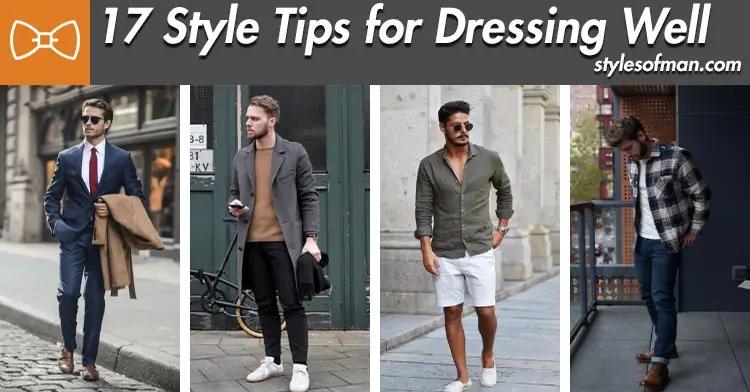In the realm of personal presentation, the way one dresses holds substantial weight. For many men, however, the art of dressing well can seem elusive, often overshadowed by the misconception that style is inherently complicated or superficial.
This guide aims to debunk those myths and provide a basic pathway toward understanding the essential elements of a well-curated wardrobe, emphasizing that dressing well is not about extravagance or trend-chasing, but about expressing one’s identity with elegance and confidence. Whether you’re a seasoned fashion enthusiast or a novice to the world of menswear, this guide offers valuable insights into cultivating a personal style that is uniquely yours.
Body Types and Dressing Tips for Men
When it comes to body types, men typically fall into one of three categories: ectomorph, mesomorph, and endomorph. Understanding your body type can greatly influence your sartorial choices and help you dress in a way that accentuates your best features.
- Ectomorph: Men with this body type are typically lean with smaller bone structures and lighter musculature. The ideal attire for this body type would be clothes that add a bit of bulk and avoid very tight fits. Layering can be a great fashion strategy for ectomorphs.
- Mesomorph: These individuals tend to have a medium build with well-defined muscles and a broad shoulder-to-waist ratio. With this body type, a well-fitted shirt and trousers can show off your physique without appearing too tight.
- Endomorph: This body type is characterized by a larger bone structure and higher amounts of total body mass and fat mass. For an endomorph, choosing clothes that create a streamlined silhouette is key. Opt for vertical stripes and avoid cluttered prints.
Remember, these are just guidelines, and every individual is unique. It’s about knowing and embracing your body type while feeling comfortable and confident in your attire.
Understanding the Color Wheel and How to Mix and Match Clothing Colors
The color wheel is a fundamental tool for understanding and applying color theory, and using it can greatly enhance your outfit coordination skills. It’s comprised of primary colors (red, blue, and yellow), secondary colors (green, orange, and purple) formed by mixing the primary colors, and tertiary colors created from a primary and secondary color.
Primary, Secondary, and Tertiary Colors
Primary colors are the building blocks of all other colors on the wheel. They are vibrant and provide a striking contrast when paired together. Secondary colors, formed when two primary colors are combined, offer a more balanced look. Tertiary colors, the combination of a primary and a secondary color, are the most nuanced and provide a subtle, sophisticated contrast.
Color Combinations
Successful color combinations for clothing can be achieved by following some basic color theory principles:
- Complementary Colors: These are colors that are opposite each other on the color wheel, such as blue and orange or red and green. Complementary colors are high contrast and can create a bold, vibrant look. For example, a navy men’s tall t-shirt could be perfectly complemented by a pair of burnt orange pants.
- Analogous Colors: These are colors that are next to each other on the color wheel, such as blue, blue-green, and green. Analogous colors create a more harmonious and less contrasting effect. A cool blue shirt with a green jacket would be an example of an analogous color scheme.
- Monochromatic Colors: These are different tones, shades, and tints within a specific hue. Dressing in monochromatic colors creates a sleek, streamlined look – for example, a light grey shirt with dark grey trousers.
While these rules can guide you in making color choices, the most important thing is to wear what makes you feel confident and comfortable. Experiment with different combinations, and remember, fashion is a form of self-expression.
Maintaining Your Clothes
Maintaining your clothes is just as important as choosing the right ones. Proper care extends the lifespan of your wardrobe and ensures that each piece retains its shape, color, and quality.
Washing
Always read and follow the care instructions on the label of your clothes. Some materials, like wool and silk, may require special treatment such as hand washing or dry cleaning. For your shirts, it’s generally best to wash them in cold water on a gentle cycle to prevent shrinking and fading.
Drying
Avoid using a dryer whenever possible. The heat from the dryer can cause fibers in your clothes to break down over time. Instead, air-dry your clothes by laying them flat or hanging them up. This is especially true for your shirts to maintain their length and fit.
Storing
How you store your clothes can also affect their longevity. Hang items like coats and dress shirts to keep them wrinkle-free. T-shirts, sweaters, and knits should be folded to maintain their shape. If you’re storing clothes for an extended period, make sure they’re clean and stored in a cool, dry place.
Repairing
Don’t discard a garment because of a missing button or minor tear. Learning basic sewing skills can help you make simple repairs and keep your clothes in rotation longer. For more complex repairs, consider seeking the help of a professional tailor.
In sum, understanding your body type and color theory are fundamental in creating an aesthetic, well-coordinated ensemble. But equally important is proper garment care, as it ensures the longevity and quality of your clothes, making them worthy investments. After all, fashion is not just about style, but also about expressing and taking care of oneself.
